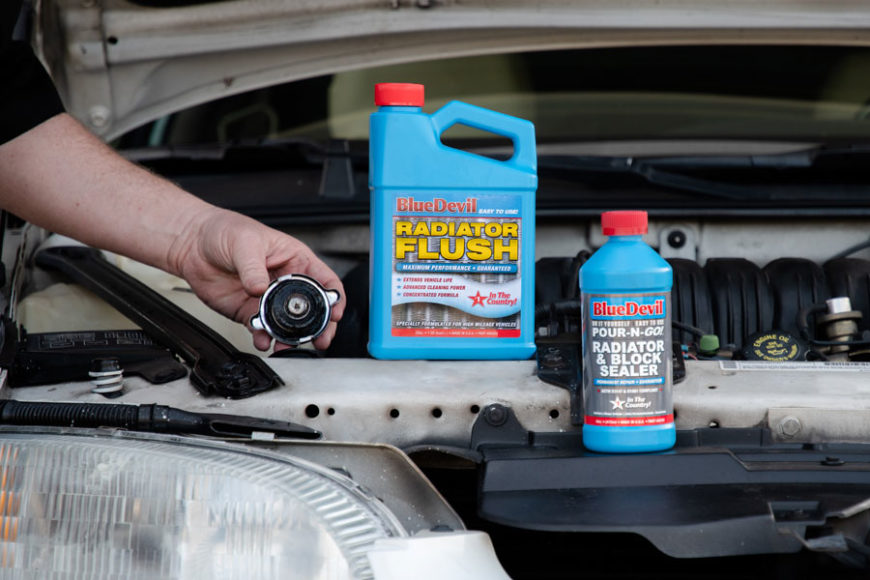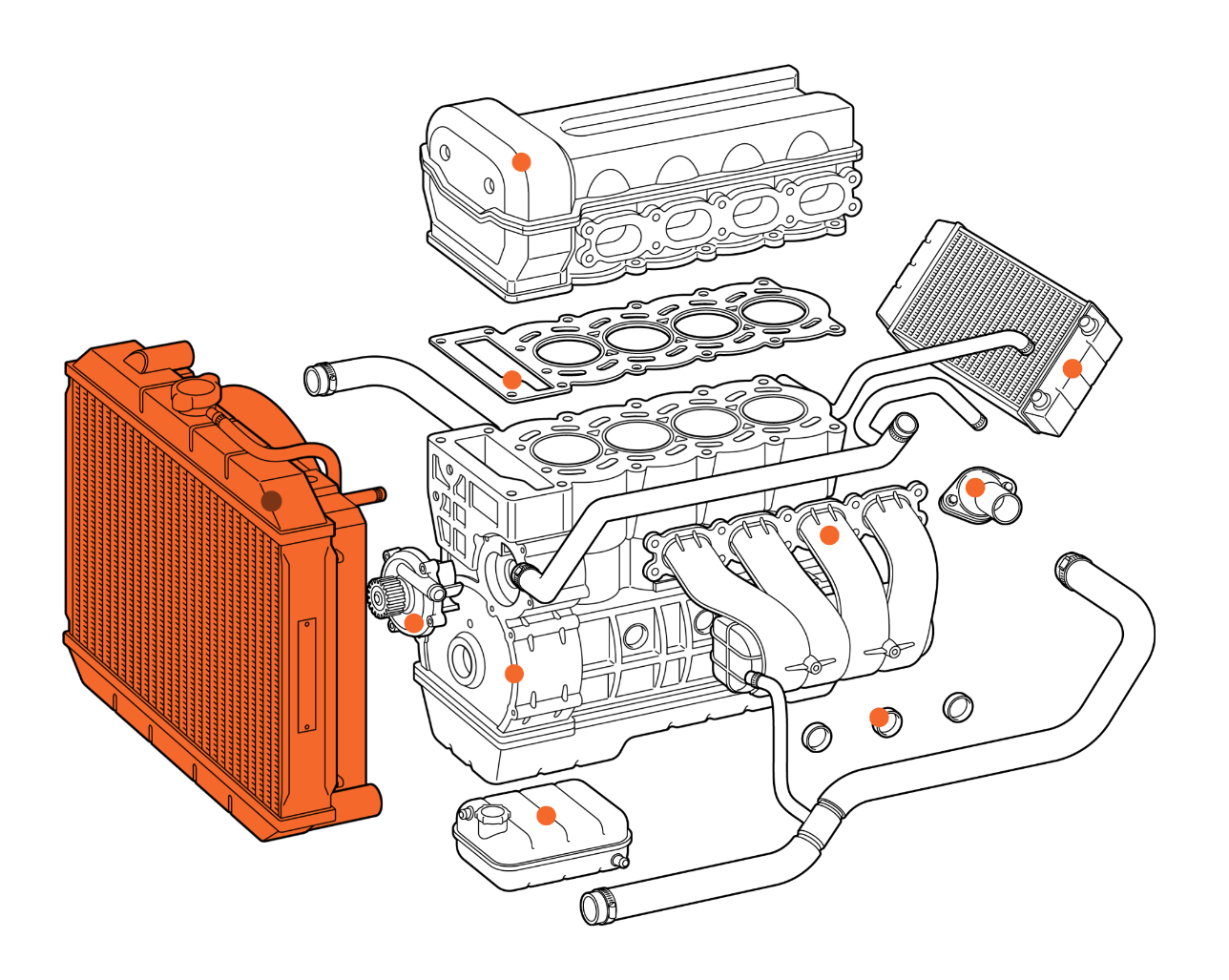Quick Fixes for Leaking Car Radiators
Got a leaking car radiator? Try quick fixes like using a radiator sealant or tightening hose clamps.
These simple solutions can help prevent further leaks and keep your car running smoothly. A leaking car radiator can be a headache, but with the right quick fixes, you can avoid costly repairs and keep your vehicle in top shape.
Whether it’s a small leak or a more significant issue, addressing the problem promptly is essential to prevent overheating and potential engine damage. By using radiator sealants, checking and tightening hose clamps, and inspecting for any visible damage, you can address the issue quickly and effectively. We’ll explore some easy and practical solutions to help you fix a leaking car radiator in no time.
:max_bytes(150000):strip_icc()/cooling-system-of-a-modern-car--leak-test-155373344-5b92fdbbc9e77c0050f5f6a1.jpg)
Credit: www.liveabout.com
Common Causes Of Car Radiator Leaks
Car radiator leaks can be a headache for any driver, causing stress and potential damage to your vehicle. Understanding the common causes of car radiator leaks can help you identify and address issues quickly to prevent further damage. Here are some common culprits to look out for:
Damaged Hoses
Damaged hoses are a frequent source of radiator leaks. Over time, aging or worn-out hoses can develop cracks or holes, leading to coolant leakage. Performing regular inspections can help prevent this common issue.
Cracked Radiator Tank
A cracked radiator tank is another prevalent cause of leaks. The plastic or metal material of the tank can deteriorate over time due to heat and pressure, resulting in cracks. Keep an eye out for any visible damage.
Faulty Radiator Cap
A faulty radiator cap can also lead to leaks. The cap maintains proper pressure in the cooling system, and if it fails to seal tightly, coolant can escape. Ensure the cap is in good condition to prevent leaks.
Signs Of A Leaking Radiator
Spotting the signs of a leaking radiator early is crucial in preventing major damage to your vehicle. Here are the key signs to watch out for:
Low Coolant Level
A low coolant level in the radiator is a clear indicator of a possible leak. If you notice that you need to frequently top up the coolant, it’s essential to inspect the radiator for any leaks.
Engine Overheating
An engine overheating is a common consequence of a leaking radiator. If you find your temperature gauge constantly running hot, it’s likely that a leak in the radiator is causing the engine to overheat.
Visible Coolant Puddles
Visible coolant puddles underneath your car after it has been parked are a strong indication of a radiator leak. The color and consistency of the puddle can also provide clues about the nature of the leak, helping you to identify the issue more precisely.
Temporary Solutions For Radiator Leaks
When facing a leaking car radiator, it’s crucial to address the issue as quickly as possible. While a permanent fix should be sought out, there are several temporary solutions that can help you contain the leak and get back on the road. It’s important to note that these quick fixes are temporary, and you should still have a professional inspect and repair the radiator at the earliest convenience.
Using A Radiator Sealant
Radiator sealants are designed to plug small leaks in the radiator, water pump, and other cooling system components. They come in liquid form and are poured into the radiator, where they flow to the source of the leak and create a temporary seal.
Applying Epoxy Putty
Epoxy putty can be a temporary solution for sealing small cracks or holes in the radiator. This moldable substance hardens into a durable material, providing a temporary fix until a proper repair can be made.
Using A Coolant Stop Leak
Coolant stop leak products are designed to stop leaks in the cooling system. They work by circulating through the system and sealing small leaks, providing a temporary solution to prevent further coolant loss.
Safety Precautions When Dealing With A Leaking Radiator
Safety Precautions when Dealing with a Leaking Radiator
Allowing The Engine To Cool Down
Before attempting any fix on a leaking radiator, ensure the engine is completely cool.
Wearing Protective Gear
Protect yourself by wearing gloves and safety goggles to prevent skin and eye irritation.
Avoiding Contact With Hot Coolant
Be cautious to not touch or inhale hot coolant fumes as they can cause burns or respiratory issues.
Permanent Solutions For Radiator Leaks
If you have a leaking car radiator, it’s crucial to find a permanent solution to avoid any further damage to your vehicle. Ignoring a radiator leak can lead to overheating, engine damage, and expensive repairs. In this section, we will discuss three permanent solutions that can effectively fix radiator leaks.
Repairing Or Replacing Damaged Hoses
If the leak is caused by a damaged hose, it’s important to repair or replace it as soon as possible. Here’s what you need to do:
- Turn off your vehicle and let it cool down completely.
- Locate the damaged hose by inspecting the radiator and engine area.
- If the hose is merely cracked or has a small hole, you can attempt to repair it using a hose repair kit.
- If the damage is significant, it’s best to replace the entire hose. Make sure to choose a hose that matches your car’s make and model.
- Carefully remove the damaged hose and install the new one, ensuring it is securely attached.
- Refill the radiator coolant and check for any signs of leakage. If everything looks good, you’ve successfully fixed the radiator leak caused by a damaged hose.
Radiator Tank Replacement
If the radiator leak is coming from the tank itself, replacing it may be the best solution. Here’s what you need to do:
- Locate the radiator drain plug and place a container underneath to catch the coolant.
- Remove the drain plug and drain all the coolant from the radiator.
- Disconnect any hoses attached to the radiator tank.
- Remove the clamps securing the old tank and carefully take it out.
- Install the new radiator tank, making sure it is securely in place.
- Reconnect all hoses and clamps, ensuring a tight fit.
- Refill the radiator with the appropriate coolant, start your vehicle, and check for any leaks. If there are no signs of leakage, you’ve successfully replaced the radiator tank.
Replacing A Faulty Radiator Cap
Believe it or not, a faulty radiator cap can sometimes be the culprit behind radiator leaks. Here’s how you can replace it:
- Make sure your vehicle is completely cooled down before proceeding.
- Locate the radiator cap, typically found on top of the radiator.
- Twist the cap counterclockwise to remove it.
- Inspect the cap for any signs of wear or damage. If you notice anything unusual, it’s time for a replacement.
- Obtain a new radiator cap that matches your car’s specifications.
- Place the new cap on the radiator, making sure it is securely fastened.
- Start your vehicle and check for any signs of leakage. If the radiator leak has stopped, you’ve successfully replaced the faulty radiator cap.
By following these permanent solutions, you can effectively fix radiator leaks and ensure the proper functioning of your car’s cooling system. However, if you’re unsure about performing these repairs yourself, it’s always recommended to seek professional assistance to avoid any further damage to your vehicle.

Credit: www.autozone.com

Credit: www.kseal.com
Frequently Asked Questions On Quick Fixes For Leaking Car Radiators
How Do You Temporarily Fix A Radiator Leak?
To temporarily fix a radiator leak, use a radiator stop leak product. Pour it into your radiator and let it circulate for the suggested time. This seals small leaks until you can have the radiator properly repaired or replaced by a professional.
How Do You Stop A Radiator Leak In An Emergency?
To stop a radiator leak in an emergency, apply a commercial radiator sealant or use white pepper as a temporary fix.
What Can I Do If My Car Radiator Is Leaking?
If your car radiator is leaking, take it to a mechanic immediately to prevent engine damage. Ignoring the issue can lead to overheating and engine failure. Regularly check for leaks and address them promptly to ensure the proper functioning of your vehicle.
Can You Fix A Radiator Leak Without Replacing It?
Yes, radiator leaks can be fixed without replacing it using sealants, epoxy, or soldering. However, it’s essential to address the issue promptly to prevent further damage. Regular maintenance and checking for leaks can also help prevent future issues.
Conclusion
Keeping your car radiator in top condition is vital for smooth operation. By following these quick fixes, you can address leaks efficiently. Regular maintenance is key to preventing major issues. Remember, addressing leaks promptly can help prolong the lifespan of your vehicle.
Stay proactive for a well-functioning radiator system.
